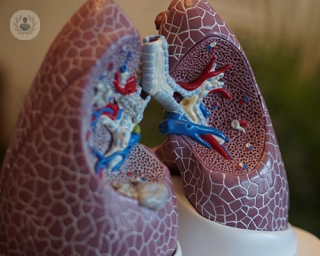Pleural biopsy
Dr Deepak Rao - Pulmonology & respiratory medicine
Created on: 12-17-2015
Updated on: 09-18-2023
Edited by: Conor Dunworth
What is pleural biopsy?
Pleural biopsy is a diagnostic technique in which the pleura, the tissue that lines the inside of the chest, is extracted and analyzed.

What happens during a pleural biopsy?
There are three types of biopsy depending on the technique used:
- Needle biopsy: also called thoracentesis, this is the most common technique and involves inserting a special needle into the pleural cavity (space between the chest wall and the pleura) to obtain the sample. It is performed under local anesthesia and can use ultrasound or computed tomography to correctly guide the insertion of the needle.
- Thoracoscopic biopsy: this involves inserting a special endoscope into the pleural cavity under local or general anesthesia. Through the endoscope, the pleural tissue can be visualized and any suspicious tissue analyzed.
- Open biopsy: this involves making an incision in the skin and removing a portion of the pleura by surgery, under general anesthesia.
Why is a pleural biopsy performed?
The main reasons why this type of biopsy is performed are:
- to diagnose the cause of a pleural infection
- to evaluate an abnormality of the pleura observed on a chest radiograph
- to determine if a pleural mass is malignant or benign
- to investigate a pleural effusion (fluid accumulated in the pleural cavity)
- to get more information if a pleural fluid test suggests the presence of cancer, tuberculosis or infection
Preparing for a pleural biopsy
Normally, fasting is not required for the procedure. The important thing for the preparation is to inform the specialist of the following:
- medicines and herbal supplements that you take
- any medical history of bleeding disorders
- any medications you take that affect blood clotting
- any chance that you might be pregnani
In some cases, a diagnostic procedure, such as computerised tomography (CT), chest x-ray, ultrasound or chest fluoroscopy, is performed beforehand to identify the exact place where the procedure should be performed.
What does the exam feel like?
In needle pleural, although the area is anesthetised, some pressure may be felt when the needle is inserted. Once the pleural fluid is removed, the needle is removed and firm pressure is applied in the area until the bleeding stops.
Meaning of abnormal results of a pleural biopsy
Abnormal results in this procedure could suggest:
- Neoplasia (abnormal tissue growth)
- Tuberculosis
- Disease caused by a virus, fungus or parasite
- Vascular collagen disease
- Lung cancer
- Mesothelioma (tumor in the lungs, heart or stomach)


